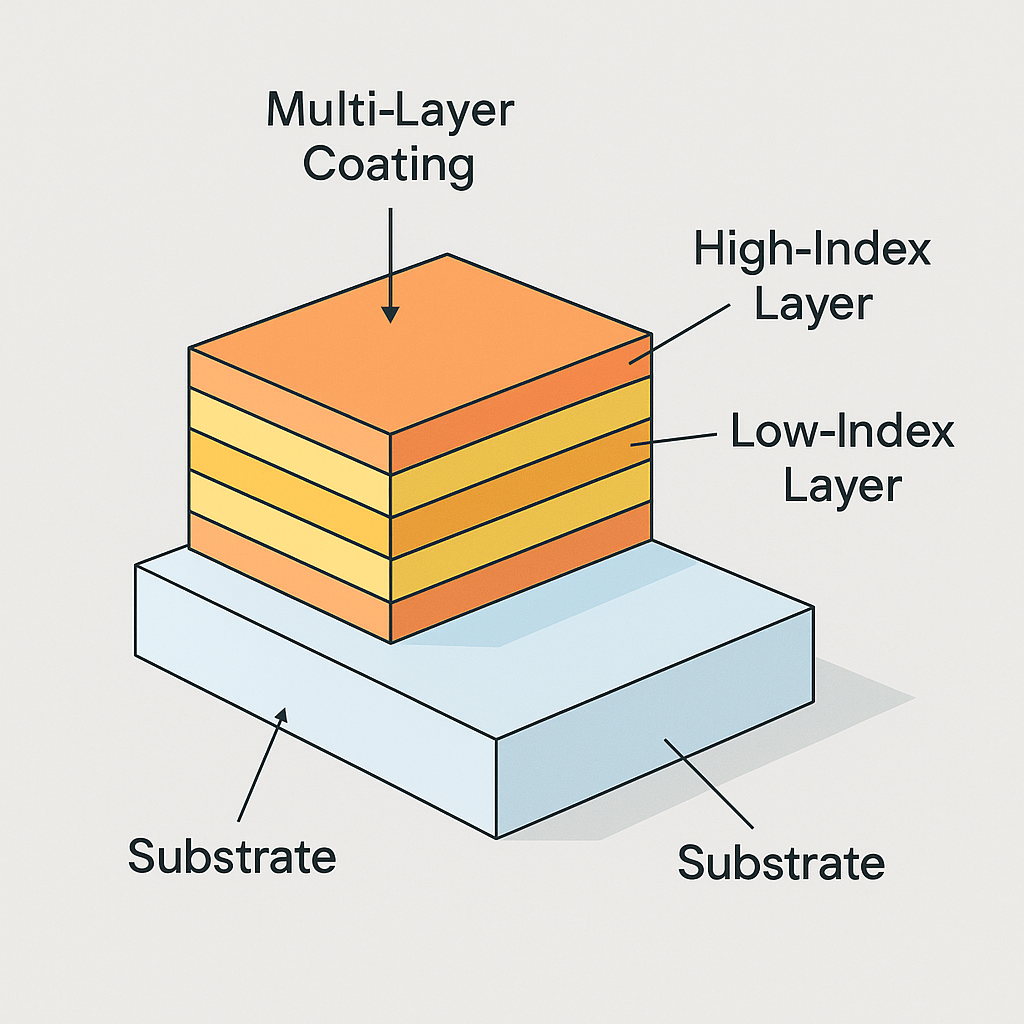
How They’re Made: A Guide To Precision Optical Lenses
Tuesday, 14 July, 2020
Achromatic Waveplates: Their Manufacturing & Applications
Friday, 7 August, 2020Polarization and Retardation
Polarization is an important quality of light enabling both its analysis and manipulation. Polarized light is described in various “states”: As a light wave travels horizontally, for example, it can have a linear polarization in the vertical direction, linear horizontal, or any angle in between. Or its polarization can twist around circularly like a corkscrew in the clockwise or counterclockwise direction. Elliptical polarization is a combination of linear and circular.
Because a circle looks the same no matter how you turn it, circular polarization can be used wherever you don’t want the orientation to change the results. Linear polarization can be completely passed or completely reflected depending on its orientation; so linear polarization can be used to direct beams onto the right track, or separate portions of a beam as desired. Any one of these states can be described as a phase retardation from any other state.
What waveplates do
Waveplates, also known as polarization retarders or just retarders, transform one state of polarization into another. Because they are thin and flat, they do their magic in a small space without displacing or deviating the path of the light beam. These features make waveplates uniquely valuable in many optical systems for many purposes.
The most popular retardation values for waveplates are the quarter-wave and half-wave. The quarter-wave transforms linear polarization to circular, or circular to linear. The half-wave transforms linear polarization from any axis to any other, or right-hand circular to left-hand circular and vice versa. Other values are used for niche purposes such as correcting elliptical polarization states to circular or linear.
What are they made from?
Waveplates are made from crystalline material such as quartz, magnesium fluoride, or sapphire. These materials have a property called birefringence that allows them to change the relative phase of light passing through them. To achieve the specific retardation desired, these materials must be precisely oriented to their crystal axis and polished to within a fraction of a micron of the proper thickness, which is different for every type and wavelength. When finished these thin flat plates are parallel to a fraction of an arc-second, their transmitted light path is free from any distortions exceeding 60 nanometers or less, and they have laser-quality surface finishes. Finally they are coated to increase their transmission to greater than 99.5%.
Different types
There are numerous waveplate types to select from. Depending on your application’s needs and budget, you can choose the one that suits you best. Most industry experts opt for one of these waveplate types:
- Multiple-order waveplates: Made from a single plate, typically quartz, this type is the economical choice when working with stable wavelength sources in a temperature-controlled environment. They are called multiple-order because in thickness values that are easier to handle and fabricate they have retardation values of N+ ¼ or N+ ½, where N is several extra wavelengths. Those extra wavelengths don’t affect the retardation directly, but they are more sensitive to wavelength and temperature changes than zero-order in proportion to their total retardation.
- Compound zero-order waveplates: These are made from two multiple-order waveplates of the same material aligned with their axes crossed so that one plate accumulates N+ ¼ or N+ ½ retardation and the other subtracts N waves for an effective total of ¼ or ½ wave. These are as precise as the single plate multiple-order and many times less sensitive to wavelength or temperature variations.
- Achromatic waveplates: Constructed of two crossed multiple-order plates of two different materials, their retardation is very nearly constant over a broad spectral band as well as having a low sensitivity to temperature variations.
- Dual-wavelength waveplates: It so happens that a multiple-order waveplate can have a retardation of N+ ¼ waves at one wavelength and M+ ½ waves at another, or various other combinations. This little trick takes a bit of calculation, but many useful combinations can be created from a single plate. Triple-wavelength solutions can sometimes be found.
Different constructions
Waveplates can be supplied unmounted or cell-mounted. Each has its advantages.
- Unmounted: Multiple-order and dual-wavelength waveplates can be supplied unmounted. At 0.5 – 0.3 mm thickness, these single plates can be handled, cleaned, and placed by a careful technician without damage. Some customers prefer the versatility this gives them. Orientation is indicated by a flat spot on the edge.
- Mounted: A cylindrical anodized aluminum cell, which protects the optical surfaces from damage and makes fixturing and mounting easier. All types can be ordered with cell mounts.
Compound zero’s and achromatic waveplates, consisting of two plates, must be accurately and permanently aligned to each other to work properly. This orientation can be achieved in several ways. It is generally inadvisable to provide two plates without some permanent connection between them.
- Air-gapped: In this construction a spacer is placed between the two plates which are tacked to the spacer with tiny dots of adhesive. This type of construction is usually provided inside a cell. Air-gapped waveplates boasts the highest laser-induced damage threshold (LIDT) while maintaining arc-second beam deviation and wavefront quality, and the greatest useful temperature range.
- Cemented: Two plates can be cemented with a special optical-grade adhesive. Once cemented they are effectively one plate. This method is economical and durable, but the beam deviation, wavefront quality, and (LIDT) suffers somewhat.
- Optically contacted: Optical contacting is a method of adhering two plates together without an adhesive. Once contacted they are effectively one plate. It maintains the arc-second beam deviation and does not degrade the wavefront or the LIDT, but optically contacted surfaces can delaminate in extreme temperature excursions, especially in larger diameters.
Work With A Supplier You Trust
When purchasing waveplates, you should pay heed to the supplier as much as the specifications of the optical device. Partnering with a manufacturer who specializes in optics and offers years of expertise is your best bet to ensure your unique application needs are met.
Tower Optical Corporation has been providing premium quality precision optics to industry experts all over the world for over 40 years. Their commitment to innovation and excellence has helped them garner a stellar reputation as one of the world’s leading manufacturers.
Offering custom, tailor-made solutions to boost industry capabilities, the full-service manufacturer also has a wide range of in-stock precision optics. Apart from over 10,000 waveplates, Tower Optical also specializes in optical filters, laser windows, beam expanders, laser mirrors, and prisms.
Each product in their inventory is available in-stock and can be made to order according to your specifications.
Contact Tower Optical at 561 740-2525 or Sales@TowerOptical.com and request a quotation for any custom or stock orders.





